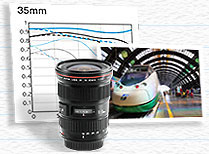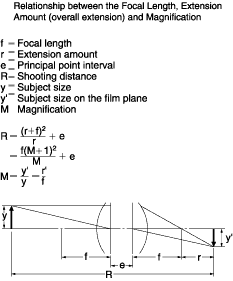|
Using the depth of field principle, as
a lens is gradually focused to farther subject
distances, a point will eventually be reached where the
far limit of the rear depth of field will be equivalent
to "infinity." The shooting distance at this point,
i.e., the closest shooting distance at which "infinity"
falls within the depth of field, is called the
hyperfocal distance. The hyperfocal distance can be
determined as follows:
 |
 |
 |
 |
| Hyperfocal distance = |
f2 |
 f: focal length f: focal length
 F: F number F: F number
 d: minimum circle of
confusion diameter d: minimum circle of
confusion diameter |
 |
| d • F |
 |
 |
 |
Thus, by presetting the lens to the
hyperfocal distance, the depth of field will extend from
a distance equal to half the hyperfocal distance to
infinity. This method is useful for presetting a large
depth of field and taking snapshots without having to
worry about adjusting the lens focus, especially when
using a wide-angle lens. (For example, when the EF 24mm
is set to f/11and the shooting distance is set to the
hyperfocal distance of approximately 1.5m/4.9ft, all
subjects within a range of approximately 70cm/2.3ft from
the camera to infinity will be in focus.) |
|
The diameter of the sharp image
circle formed by a lens. Interchangeable lenses for 35mm
format cameras must have an image circle at least as
large as the diagonal of the 24 x 36mm image area, and
EF lenses generally have an image circle of about
43.2mm. TS-E lenses, however, are designed with a larger
image circle of 58.6mm to cover the lens’ tilt and shift
movements. |
|
A superb new technology that allows
the lens to sense movement from "shake" or vibrations,
and instantly apply an optical correction by moving a
group of lens elements. The improvement in steadiness
can be seen even in the viewfinder, and most users find
they can shoot hand-held or on a monopod at shutter
speeds about two stops slower than previously possible
and consistently get sharp images. More
information |
|
A numerical value indicating the
degree of refraction of a medium, expressed by the
formula n=sin i/sin r is a constant which is unrelated
to the light ray's angle of incidence and indicates the
refractive index of the refracting medium with respect
to the medium from which the light impinges. For general
optical glass, "n" usually indicates the index of
refraction of the glass with respect to air. |
![]()

